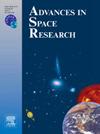IF 2.8
3区 地球科学
Q2 ASTRONOMY & ASTROPHYSICS
引用次数: 0
摘要
火星快车上的空间等离子体和高能原子分析器(ASPERA-3)等离子体软件包观测到了火星地表下和电离层探测高级雷达(MARSIS)以主动电离层探测模式运行时加速的离子和电子。为了更好地研究其中的过程,为火星探测和电离层探测高级雷达开发了新的运行模式。在第一种固定频率模式中,发射机不像通常那样在一定频率范围内扫描,而是以固定频率发射脉冲。这个频率被选择为接近航天器周围当地电离层的基频,在任何情况下都是 350 千赫。此外,还引入了一种交替模式,即在固定频率模式下进行的观测与在不同频率上进行的观测交错进行,以研究离子是如何加速的。本文章由计算机程序翻译,如有差异,请以英文原文为准。
Mars Express investigations of the Martian ionosphere using ASPERA-3 and new MARSIS fixed frequency modes
The plasma package Analyzer of Space Plasma and Energetic Atoms (ASPERA-3) onboard Mars Express has observed ions and electrons accelerated by the Mars Advanced Radar for Subsurface and Ionosphere Sounding (MARSIS) radar when it operates in its active ionospheric sounding mode. To better study the processes involved, new operational modes for MARSIS have been developed. In the first, a fixed frequency mode, the transmitter does not sweep over a range of frequencies, as normal, but instead transmits pulses at a fixed frequency. This frequency has been chosen to be close to the fundamental frequency of the local ionosphere around the spacecraft, which in all cases is < 350 kHz. Also, an alternating mode has been introduced, where observations in the fixed frequency mode are interleaved with observations that sweep over frequencies in order to investigate how ions are accelerated.
Here we describe the new operational modes and present the results of several tests performed in the years 2020, 2021, and 2023.
求助全文
通过发布文献求助,成功后即可免费获取论文全文。
去求助
来源期刊

Advances in Space Research
地学天文-地球科学综合
CiteScore
5.20
自引率
11.50%
发文量
800
审稿时长
5.8 months
期刊介绍:
The COSPAR publication Advances in Space Research (ASR) is an open journal covering all areas of space research including: space studies of the Earth''s surface, meteorology, climate, the Earth-Moon system, planets and small bodies of the solar system, upper atmospheres, ionospheres and magnetospheres of the Earth and planets including reference atmospheres, space plasmas in the solar system, astrophysics from space, materials sciences in space, fundamental physics in space, space debris, space weather, Earth observations of space phenomena, etc.
NB: Please note that manuscripts related to life sciences as related to space are no more accepted for submission to Advances in Space Research. Such manuscripts should now be submitted to the new COSPAR Journal Life Sciences in Space Research (LSSR).
All submissions are reviewed by two scientists in the field. COSPAR is an interdisciplinary scientific organization concerned with the progress of space research on an international scale. Operating under the rules of ICSU, COSPAR ignores political considerations and considers all questions solely from the scientific viewpoint.
 求助内容:
求助内容: 应助结果提醒方式:
应助结果提醒方式:


